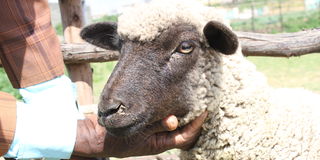What makes Molo lamb internationally famous?

Molo lamb has been internationally acclaimed for the tender nature of the meat.
Molo lamb is known by avid meat lovers all over the country, with its fame spreading beyond Kenya’s borders.
But what exactly is Molo lamb? Where are they reared? What makes them famous?
Njenga Matendo, a sheep farmer in Molo, sheds a light on these questions.

Mr Matendo rears sheep at his farm in Molo.
“There’s actually no breed of sheep known as Molo lamb. The original breed of sheep that was being sold as Molo lamb were the Merino breed. The term was coined for Molo farmers to embrace rearing of the sheep and distinguish the meat even in international markets,” Mr. Njenga shares.
However, Mr. Njenga notes that over the years, the sheep that are referred to and reared as Molo sheep have changed with most farmers, himself included, rearing interbreeds of Hampshire and Merino as Molo lamb.
Mr. Njenga, whose parents were also farmers says rearing of Molo lamb was a very successful business back in the '80s.
“At the time, the Merino breed (Molo lamb) were a main source of income for many Molo farmers, myself included. Many would flock our small town just to have a taste of the Molo lamb dish. Apart from its meat, we also reaped big on selling the sheep’s wool which many industries depended on,” he reminisces.
The farmer who also doubles up as a pastor shares that the collapse of Molo lamb rearing in the area began in the '90s.
Mr. Njenga highlights, “During the 1990s, there was a lot of political instability which affected Molo, with many farmers losing their land or properties. Additionally, the government also dropped its interest in agriculture and as a result, the pure Merino breeds began getting mixed with other breeds.”
Despite this hardship, Mr. Matendo still decided to keep rearing Molo lamb, a decision he doesn’t regret.
When pointing out the difference between Molo lamb and other sheep he shares, “Molo lamb meat is more tender and sweeter. Also, the wool produced by these sheep is more than what other sheep can produce. Molo sheep also have a high survival rate.”
However, Molo lamb rearing is not without its own challenges.
“The biggest challenge we face is insecurity. A lot of our livestock are stolen especially if you rear pure breeds."
Mr Matendo says the lack of regulation in the beef industry is also a problem, as anyone is able to interbreed, passing off these sheep as a pure merino breed.
“This affects the quality of meat, which reflects negatively on other farmers.”
In his final remarks, Mr Matendo urges the government to revive Molo lamb rearing.
“Molo lamb farming has served as a big revenue earner for a lot of us in Molo with Kenya even curving out a name for itself when exporting the meat. Unless the government steps in to promote rearing of pure Merino sheep by farmers, the Molo lamb will soon turn into a myth,” he says.
